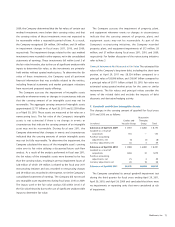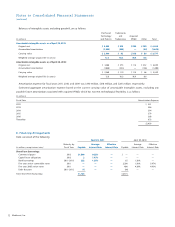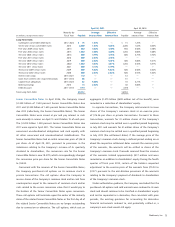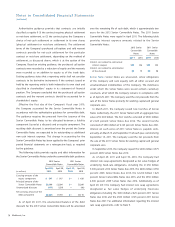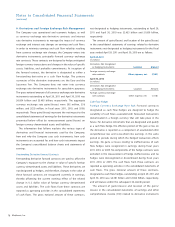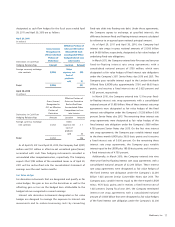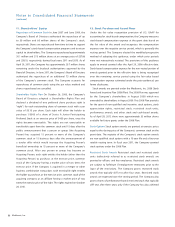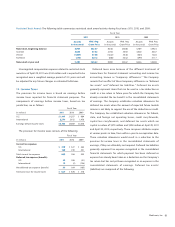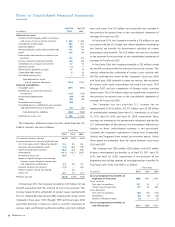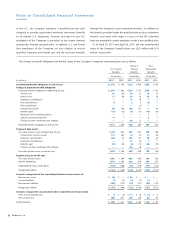Medtronic 2011 Annual Report Download - page 85
Download and view the complete annual report
Please find page 85 of the 2011 Medtronic annual report below. You can navigate through the pages in the report by either clicking on the pages listed below, or by using the keyword search tool below to find specific information within the annual report.
81
Medtronic, Inc.
certain performance objectives. Performance awards are expensed
over the performance period based on the probability of
achieving the performance objectives. Shares of restricted stock
are considered issued and outstanding shares of the Company at
the grant date and have the same dividend and voting rights
as other shares of common stock. Restricted stock units are not
considered issued or outstanding common stock of the Company.
Dividend equivalent units are accumulated on restricted stock
units during the vesting period. In fiscal year 2011, the Company
granted restricted stock awards under the 2008 Plan.
Employee Stock Purchase Plan The Medtronic, Inc. 2005 Employee
Stock Purchase Plan (ESPP) allows participating employees to
purchase shares of the Company’s common stock at a discount
through payroll deductions. Employees can contribute up to the
lesser of 10 percent of their wages or the statutory limit under the
U.S. Internal Revenue Code toward the purchase of the Company’s
common stock at 85 percent of its market value at the end of
the calendar quarter purchase period. Employees purchased 3
million shares at an average price of $30.83 per share in the fiscal
year ended April 29, 2011. As of April 29, 2011, plan participants
have had approximately $8 million withheld to purchase
Company common stock at 85 percent of its market value on
June 30, 2011, the last trading day before the end of the calendar
quarter purchase period. At April 29, 2011, approximately 12
million shares of common stock were available for future purchase
under the ESPP.
Valuation Assumptions The Company uses the Black-Scholes
option pricing model (Black-Scholes model) to determine the fair
value of stock options as of the grant date. The fair value of stock
options under the Black-Scholes model requires management to
make assumptions regarding projected employee stock option
exercise behaviors, risk-free interest rates, volatility of the
Company’s stock price, and expected dividends.
The expense recognized for shares purchased under the
Company’s ESPP is equal to the 15 percent discount the employee
receives at the end of the calendar quarter purchase period. The
expense recognized for restricted stock awards is equal to the
grant date fair value, which is equal to the closing stock price on
the date of grant.
The following table provides the weighted average fair value of
options granted to employees and the related assumptions used
in the Black-Scholes model:
Fiscal Year
2011 2010 2009
Weighted average fair value
of options granted $8.19 $8.77 $8.96
Assumptions used:
Expected life (years)(a) 6.30 6.16 6.05
Risk-free interest rate(b) 2.25% 3.17% 3.11%
Volatility(c) 26.03% 26.91% 25.64%
Dividend yield(d) 2.40% 2.29% 2.03%
(a) Expected life: The Company analyzes historical employee stock option exercise
and termination data to estimate the expected life assumption. The Company
calculates the expected life assumption using the midpoint scenario, which
combines historical exercise data with hypothetical exercise data, as the
Company believes this data currently represents the best estimate of the
expected life of a new employee option. The Company also stratifies its employee
population into two groups based upon distinctive exercise behavior patterns.
(b) Risk-free interest rate: The rate is based on the grant date yield of a zero-
coupon U.S. Treasury bond whose maturity period equals the expected term of
the option.
(c) Volatility: Expected volatility is based on a blend of historical volatility and an
implied volatility of the Company’s common stock. Implied volatility is based on
market traded options of the Company’s common stock.
(d) Dividend yield: The dividend yield rate is calculated by dividing the Company’s
annual dividend, based on the most recent quarterly dividend rate, by the
closing stock price on the grant date.
Stock-Based Compensation Expense Upon the adoption of the fair
value recognition provisions of U.S. GAAP for accounting for
stock-based compensation, the Company changed its method
of recognition and now recognizes stock-based compensation
expense based on the substantive vesting period for all new
awards. As a result, compensation expense related to stock
options granted prior to fiscal year 2007 is being recognized over
the stated vesting term of the grant rather than being accelerated
upon retirement eligibility.
The amount of stock-based compensation expense recognized
during a period is based on the portion of the awards that are
ultimately expected to vest. The Company estimates pre-vesting
forfeitures at the time of grant by analyzing historical data and
revises those estimates in subsequent periods if actual forfeitures
differ from those estimates. Ultimately, the total expense
recognized over the vesting period will equal the fair value of
awards that actually vest.


